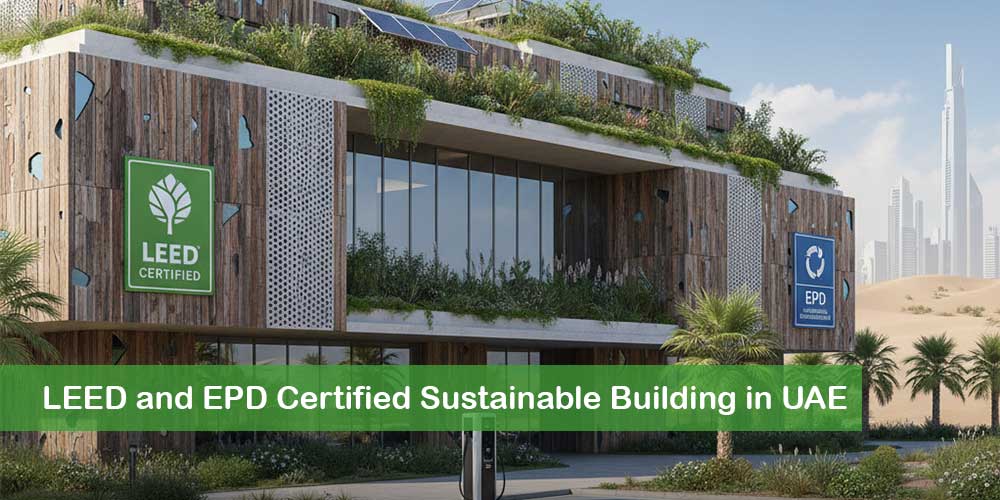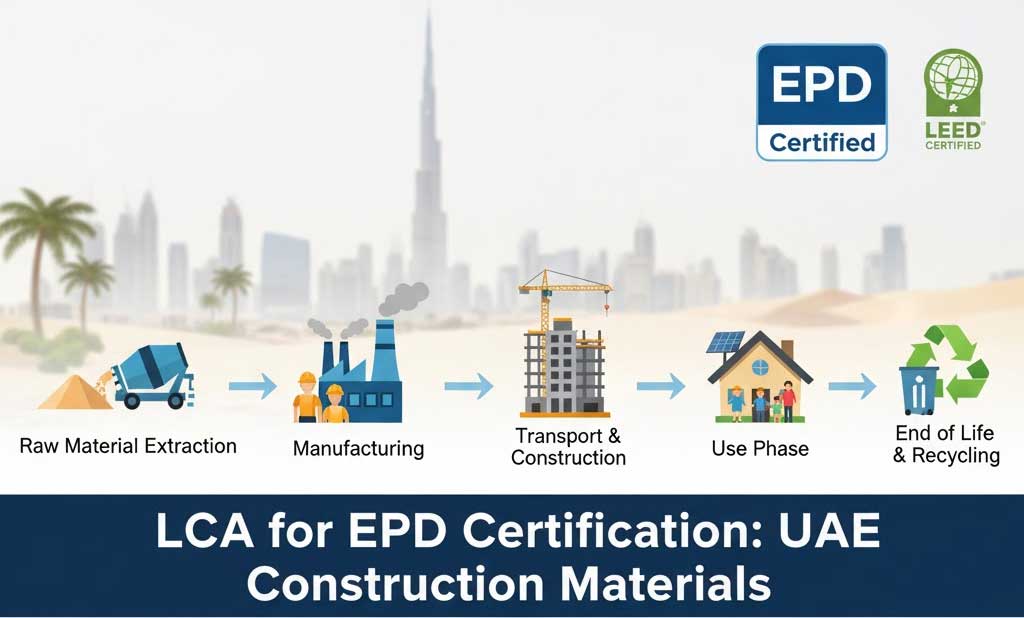Introduction – Why LEED EPD Certifications Matter in UAE and Saudi Arabia Construction
The UAE and Saudi Arabia are swiftly emerging as pioneers in sustainable construction, propelled by initiatives like the Dubai Municipality Green Building Regulations, Estidama Pearl Rating System, Masdar City’s eco-friendly developments, and Saudi Arabia’s Vision 2030 sustainability ambitions. For builders, contractors, and manufacturers in these regions, obtaining LEED and Environmental Product Declaration (EPD) certifications is more than a promotional advantage—it is an essential step to showcase environmental stewardship and secure a competitive market position.

LEED (Leadership in Energy and Environmental Design) is an internationally recognized certification system that assesses sustainability aspects such as energy efficiency, water conservation, raw material sourcing, and overall environmental impact. EPD certification, on the other hand, provides a standardized, ISO-compliant report based on life cycle assessment (LCA) that transparently details a product’s environmental footprint throughout its entire lifespan—from production procedures and energy consumption to waste generation and disposal.
Pro Tip: Engaging early in the EPD certification process can simplify approval and maximize sustainability outcomes, supporting your sustainability goals.
Table of Contents
- What Is LEED EPD Certification UAE and Why Is It Important?
- How Does Envirolink Support Your LEED EPD Certification Journey?
- Top 5 Benefits of LEED EPD Certification for UAE and Saudi Arabia Builders and Manufacturers
- 1. How Does Certification Enhance Market Credibility and Brand Value?
- 2. How Can LEED Credits and Green Building Projects Be Accessed?
- 3. What Role Does Certification Play in Reducing Environmental Footprint and Operational Costs?
- 4. Why Is Meeting Regulatory and Procurement Requirements Critical?
- 5. How Does Certification Improve Supplier Engagement and Supply Chain Transparency?
- Understanding the LEED EPD Certification Process
- Common Challenges and Solutions in LEED EPD Certification
- Why Choose Envirolink for Your LEED EPD Certification Needs?
- Conclusion
- FAQ
What Is LEED EPD Certification UAE and Why Is It Important?
LEED EPD certification UAE merges the comprehensive standards of LEED with the transparent environmental product declaration framework. This dual certification verifies that construction materials and industrial products conform to stringent environmental criteria, fostering sustainable building practices throughout the region. It serves as an indispensable resource for builders and manufacturers striving to comply with global sustainability standards and regulatory mandates, while enhancing their competitive positioning.
By combining LEED’s emphasis on energy and environmental design with the detailed environmental product declaration (EPD) process, stakeholders can provide verified insights into a product’s environmental footprint, covering everything from raw material sourcing and manufacturing to waste disposal and water consumption. This level of transparency promotes sustainable development and aligns with rising market expectations for green certifications.
How Does Envirolink Support Your LEED EPD Certification Journey?
Envirolink provides end-to-end services customized for builders and manufacturers in the UAE and Saudi Arabia. We collaborate closely with clients throughout the entire process to ensure data accuracy, consistency, and compliance in life cycle assessments and EPD development.
Our offerings include:
- Conducting comprehensive Life Cycle Assessments (LCA) to generate precise environmental impact reports and lca reports
- Preparing EPD documents in standardized formats that adhere to ISO standards and product category rules
- Managing the verification process with accredited third-party verifiers and EPD program operators
- Supporting documentation, regulatory compliance, and publication to enhance market competitiveness
Partnering with Envirolink allows companies to navigate the certification process smoothly, identify areas for continuous improvement, uncover environmental improvement opportunities, and reduce time and cost burdens with cost effectiveness.
Top 5 Benefits of LEED EPD Certification for UAE and Saudi Arabia Builders and Manufacturers
1. How Does Certification Enhance Market Credibility and Brand Value?
LEED and EPD certifications act as credible endorsements of a company’s commitment to environmental stewardship and sustainable development. Builders and manufacturers offering EPD-certified construction materials and industrial products earn greater trust from architects, contractors, regulators, and eco-conscious clients.
Key Advantages:
- Elevate brand reputation and reliability in competitive markets
- Differentiate products with validated environmental performance data
- Strengthen sustainability credentials for global market access and export potential
- Build consumer confidence and loyalty through transparent environmental claims
Certification also demonstrates compliance with relevant standards, ensuring consistency and compliance purposes, reassuring stakeholders that products meet rigorous environmental benchmarks. This enhanced credibility can unlock numerous benefits including new business opportunities and partnerships.

2. How Can LEED Credits and Green Building Projects Be Accessed?
Incorporating EPD-certified building materials supports LEED credits, especially under the Materials and Resources (MR) category, which can boost a project’s LEED rating and increase property value and tenant appeal.
Benefits Include:
- Contribution to achieving higher LEED certification levels for construction projects
- Alignment with UAE and Saudi Arabia green building codes and regulatory compliance
- Attraction of developers and clients prioritizing sustainable building practices
Using EPD-certified products helps builders comply with green building standards such as Estidama and Dubai Green Building Code, which are increasingly favored by governmental and private sector clients.
3. What Role Does Certification Play in Reducing Environmental Footprint and Operational Costs?
The EPD certification process involves detailed life cycle assessments that highlight opportunities to optimize resource consumption, including energy consumption, water usage, and raw materials. This results in lowered greenhouse gas emissions and a reduced carbon footprint across the product’s entire life cycle.
Benefits:
- Decrease operational costs through improved production efficiency and resource management
- Support sustainable procurement aligned with corporate sustainability goals
- Promote continuous improvement of environmental performance and product innovation
By analyzing environmental impacts via LCA results, companies can innovate production processes, minimize waste generation and energy use, and improve product quality.
Did You Know? Companies implementing EPDs often identify areas and opportunities for cost-saving measures previously unnoticed.
4. Why Is Meeting Regulatory and Procurement Requirements Critical?
Governments in the UAE and Saudi Arabia are increasingly mandating or encouraging green certifications for public tenders and large infrastructure projects. LEED and EPD certifications ensure companies meet these evolving standards and maintain regulatory compliance.
Importance:
- Qualify for government and semi-government contracts
- Position as preferred suppliers for sustainable development projects
- Reduce risks of project delays due to non-compliance with environmental regulations
- Fulfill current and anticipated regulatory requirements proactively
Compliance through certification helps companies avoid penalties and strengthens their reputation as responsible corporate citizens.
5. How Does Certification Improve Supplier Engagement and Supply Chain Transparency?
Developing an EPD requires comprehensive data collection from across the supply chain, enhancing transparency and accountability among suppliers. This fosters stronger relationships and supports corporate sustainability reporting and ESG goals.
Additional Benefits:
- Improve data accuracy for sustainability disclosures
- Prepare for future regulatory and certification demands
- Enable informed decisions regarding product selection and environmental impact
By encouraging supplier collaboration, companies can build resilient, sustainable supply chains that contribute to long-term success and environmental responsibility.
Understanding the LEED EPD Certification Process
The LEED EPD certification process includes several key steps to ensure thorough assessment and transparency:
- Defining System Boundaries and Scope: Establish clear product system boundaries and certification goals for focused evaluations.
- Data Collection: Gather detailed information on raw material sourcing, energy consumption, production methods, waste generation, and disposal.
- Life Cycle Assessment (LCA): Perform in-depth LCA using advanced tools to produce accurate environmental impact reports.
- EPD Document Preparation: Create EPD documents in standardized formats compliant with ISO 14025 and product category rules, ensuring clarity and comparability.
- Verification Process: Coordinate with accredited third-party verifiers to validate LCA results and EPD documents for accuracy and compliance.
- Publication: Assist in publishing the certified EPD via recognized program operators for regulatory and market use.
This structured approach guarantees transparent communication of a product’s environmental performance to stakeholders.
Common Challenges and Solutions in LEED EPD Certification
Obtaining LEED EPD/Estidama/Mostadam certification may involve challenges such as data gaps, technical complexities, and cost concerns. These can be effectively managed as follows:
- Data Gaps: Some manufacturers may lack detailed lifecycle data. Solution: Envirolink fills these gaps through on-site audits and reliable secondary data sources.
- Technical Complexity: Navigating ISO standards and product category rules can be daunting. Solution: Our experts handle LCA modeling and verifier coordination.
- Cost Concerns: Small and medium enterprises may worry about return on investment. Solution: Certification often reduces bid rejections and opens export markets, frequently paying off within 6 to 12 months.
By addressing these issues proactively, companies can streamline certification and maximize its numerous benefits.
Why Choose Envirolink for Your LEED EPD Certification Needs?
Envirolink distinguishes itself as a trusted partner for LEED EPD certification in the UAE and Saudi Arabia by:
- Collaborating closely with clients to understand their sustainability objectives and market challenges
- Ensuring quality and consistency throughout the certification journey, from data collection to publication
- Offering competitive and tailored solutions suited to your product and industry
- Staying current with regional regulations, international standards, and green building certifications
- Providing dedicated support to overcome common hurdles and simplify your certification process
Our commitment to client success makes us the preferred choice for builders and manufacturers pursuing LEED EPD/Estidama/Mostadam certification.
Conclusion
Securing LEED EPD certification UAE is a crucial step for builders and manufacturers dedicated to fostering a sustainable future. By engaging in the full certification process—from defining system boundaries and collecting data to conducting life cycle assessments, third-party verification, and publication—companies can transparently demonstrate environmental responsibility, reduce their product’s ecological footprint, and gain a competitive advantage across various sectors such as construction materials, consumer goods, and industrial products. Envirolink’s expert guidance streamlines this entire process, helping clients identify improvement areas, maintain regulatory compliance, and enhance market positioning. LEED and EPD certifications are more than compliance tools; they are critical tools driving sustainable development and long-term success in the UAE and Saudi Arabia.
FAQ
It is a combined certification integrating LEED green building standards with Environmental Product Declaration (EPD) processes to verify and communicate a product’s environmental performance through its entire lifecycle.
Envirolink provides comprehensive support including data collection, life cycle assessment, EPD document preparation, coordination of third-party verification, and publication assistance.
EPD certification offers transparent, standardized information about a product’s environmental impact, supporting regulatory compliance and green building certifications.
The process typically takes between 6 to 12 weeks, depending on product complexity and verification requirements.
Costs vary based on product scope and verification needs. Envirolink provides customized quotes to ensure cost effectiveness.
Yes, if the products share similar manufacturing processes and environmental impacts, a single EPD can cover them.
EPD certification is generally valid for five years, after which lifecycle data and assessments must be updated and re-verified to maintain accuracy and compliance.


